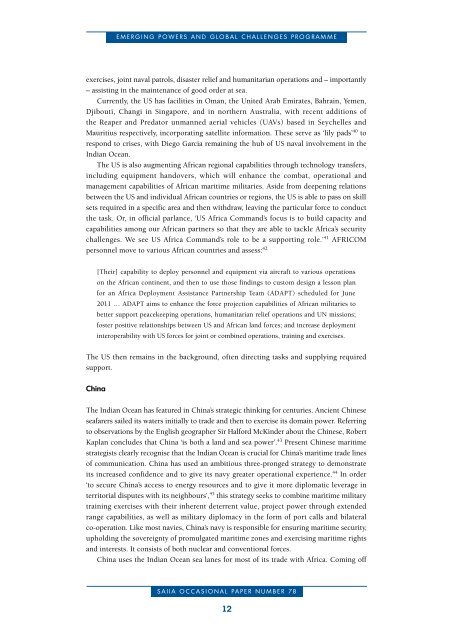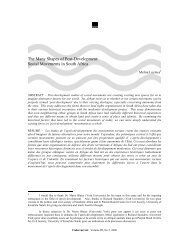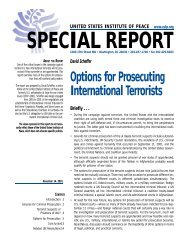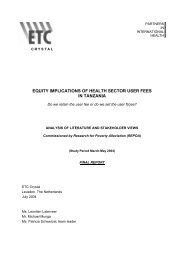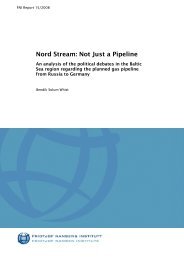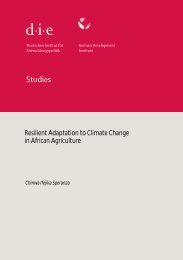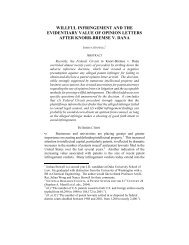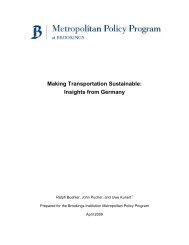Africa and the Geopolitics of the Indian Ocean
Africa and the Geopolitics of the Indian Ocean
Africa and the Geopolitics of the Indian Ocean
You also want an ePaper? Increase the reach of your titles
YUMPU automatically turns print PDFs into web optimized ePapers that Google loves.
EMERgINg POwERS ANd gLOBAL ChALLENgES PROgRAMME<br />
exercises, joint naval patrols, disaster relief <strong>and</strong> humanitarian operations <strong>and</strong> – importantly<br />
– assisting in <strong>the</strong> maintenance <strong>of</strong> good order at sea.<br />
Currently, <strong>the</strong> US has facilities in Oman, <strong>the</strong> United Arab Emirates, Bahrain, Yemen,<br />
Djibouti, Changi in Singapore, <strong>and</strong> in nor<strong>the</strong>rn Australia, with recent additions <strong>of</strong><br />
<strong>the</strong> Reaper <strong>and</strong> Predator unmanned aerial vehicles (UAVs) based in Seychelles <strong>and</strong><br />
Mauritius respectively, incorporating satellite information. These serve as ‘lily pads’ 40 to<br />
respond to crises, with Diego Garcia remaining <strong>the</strong> hub <strong>of</strong> US naval involvement in <strong>the</strong><br />
<strong>Indian</strong> <strong>Ocean</strong>.<br />
The US is also augmenting <strong>Africa</strong>n regional capabilities through technology transfers,<br />
including equipment h<strong>and</strong>overs, which will enhance <strong>the</strong> combat, operational <strong>and</strong><br />
management capabilities <strong>of</strong> <strong>Africa</strong>n maritime militaries. Aside from deepening relations<br />
between <strong>the</strong> US <strong>and</strong> individual <strong>Africa</strong>n countries or regions, <strong>the</strong> US is able to pass on skill<br />
sets required in a specific area <strong>and</strong> <strong>the</strong>n withdraw, leaving <strong>the</strong> particular force to conduct<br />
<strong>the</strong> task. Or, in <strong>of</strong>ficial parlance, ‘US <strong>Africa</strong> Comm<strong>and</strong>’s focus is to build capacity <strong>and</strong><br />
capabilities among our <strong>Africa</strong>n partners so that <strong>the</strong>y are able to tackle <strong>Africa</strong>’s security<br />
challenges. We see US <strong>Africa</strong> Comm<strong>and</strong>’s role to be a supporting role.’ 41 AFRICOM<br />
personnel move to various <strong>Africa</strong>n countries <strong>and</strong> assess: 42<br />
[Their] capability to deploy personnel <strong>and</strong> equipment via aircraft to various operations<br />
on <strong>the</strong> <strong>Africa</strong>n continent, <strong>and</strong> <strong>the</strong>n to use those findings to custom design a lesson plan<br />
for an <strong>Africa</strong> Deployment Assistance Partnership Team (ADAPT) scheduled for June<br />
2011 … ADAPT aims to enhance <strong>the</strong> force projection capabilities <strong>of</strong> <strong>Africa</strong>n militaries to<br />
better support peacekeeping operations, humanitarian relief operations <strong>and</strong> UN missions;<br />
foster positive relationships between US <strong>and</strong> <strong>Africa</strong>n l<strong>and</strong> forces; <strong>and</strong> increase deployment<br />
interoperability with US forces for joint or combined operations, training <strong>and</strong> exercises.<br />
The US <strong>the</strong>n remains in <strong>the</strong> background, <strong>of</strong>ten directing tasks <strong>and</strong> supplying required<br />
support.<br />
China<br />
The <strong>Indian</strong> <strong>Ocean</strong> has featured in China’s strategic thinking for centuries. Ancient Chinese<br />
seafarers sailed its waters initially to trade <strong>and</strong> <strong>the</strong>n to exercise its domain power. Referring<br />
to observations by <strong>the</strong> English geographer Sir Halford McKinder about <strong>the</strong> Chinese, Robert<br />
Kaplan concludes that China ‘is both a l<strong>and</strong> <strong>and</strong> sea power’. 43 Present Chinese maritime<br />
strategists clearly recognise that <strong>the</strong> <strong>Indian</strong> <strong>Ocean</strong> is crucial for China’s maritime trade lines<br />
<strong>of</strong> communication. China has used an ambitious three-pronged strategy to demonstrate<br />
its increased confidence <strong>and</strong> to give its navy greater operational experience. 44 In order<br />
‘to secure China’s access to energy resources <strong>and</strong> to give it more diplomatic leverage in<br />
territorial disputes with its neighbours’, 45 this strategy seeks to combine maritime military<br />
training exercises with <strong>the</strong>ir inherent deterrent value, project power through extended<br />
range capabilities, as well as military diplomacy in <strong>the</strong> form <strong>of</strong> port calls <strong>and</strong> bilateral<br />
co-operation. Like most navies, China’s navy is responsible for ensuring maritime security,<br />
upholding <strong>the</strong> sovereignty <strong>of</strong> promulgated maritime zones <strong>and</strong> exercising maritime rights<br />
<strong>and</strong> interests. It consists <strong>of</strong> both nuclear <strong>and</strong> conventional forces.<br />
China uses <strong>the</strong> <strong>Indian</strong> <strong>Ocean</strong> sea lanes for most <strong>of</strong> its trade with <strong>Africa</strong>. Coming <strong>of</strong>f<br />
SAIIA OCCASIONAL PAPER NUMBER 78<br />
12


